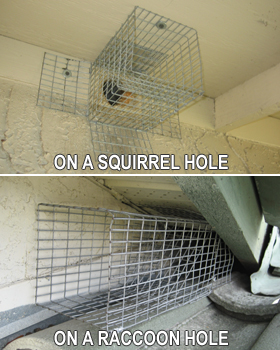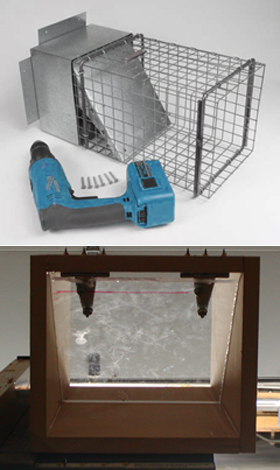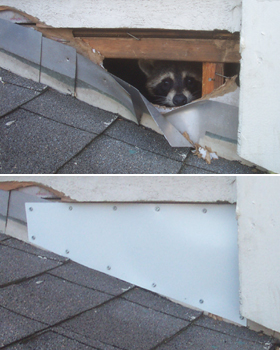I don't have to trap them in cages? - No. In many cases, wildlife can be excluded via one-way doors or funnels. Look at the photos to the left. You will see one-way exclusion doors. These are basically slanted doors
with torsion springs. The animal(s) in the attic have to go outside periodically, to get water and food. Some animals like squirrels go in and out several times a day, but in the case of raccoons, usually just at night. So all you have to
do is find the hole they are using to get in and out, make sure there are no other open holes, and mount a one-way exclusion door on that hole. Next time they go out, they will be locked out and can't get back in! It's a great solution,
because it's easier on the raccoons than cage trapping. They will be left in their native territory, which they know well. Raccoon relocation is often hard on the animals.
Does it always work? - Not always. It's a great technique for skunks, squirrels, rats, and bats. But raccoons are a bit different, because they are so agile and strong. If a raccoon really wants to get back inside your
attic, it will be able to do so. It often can rip the one-way door right out, unless you've managed to really bolt it in well. It can find a new area of the house to rip open. Raccoon even commonly tear right through the roof, through
the shingles and wood, to get in an attic. So this technique isn't so fool-proof with raccoons. However, in some cases it will work - if you have a sturdy house, can mount the one-way door in a very secure way, and have a less-than-fully
motivated raccoon, this technique will work.
What if there's a nest of babies inside? - That's the big limitation with raccoon exclusion from an attic. Most of the time, a female in an attic is a mother with a litter of babies inside. If you block her out, she'll
just tear her way back inside, and there's no stopping her. Believe me, we've experienced this firsthand a few times before we learned! So the reality is that if you have a raccoon in the attic, exclusion won't work very well. But luckily,
there are easier ways to get raccoons out of the attic if you read our page about it.
When WILL exclusion work, then? - The best case is an isolated adult, like a male, living under a house, or porch or shed. In that case, if you can block off all other areas of entry/exit, and narrow it down to just one
small spot, you can install a one-way exclusion door there. If you are certain that a raccoon in the attic is not a female with young, it might work then, but truth be told, this is impossible, unless you can get up close to look for
lactating nipples. If the young in the attic are older, at least 10 weeks old, they will be able to push their way out of the one-way door, and it's possible that the mom will decide to stay out with them.
What equipment do I need? - You can buy one-way doors like in the photos to the left. The one with the plexiglass door was custom made by a trapper for his own use, but the other metal ones are for sale online. Then all
you need are bolts/screws and washers to mount the door. An electric screwdriver/drill is a big help. Also, some extra steel screening or flashing will likely come in handy to block off adjacent areas of architecture so that there
are no other openings or easy areas for a raccoon to grip the door and rip it out.
Bottom Line - Exclusion is a great tool for many animals and situations, but it's not always practical with raccoons, and it's not really a very good idea when you have raccoons in the attic, because of the likelihood of
baby raccoons in the attic.
For effective ways to solve a raccoon problem yourself, or to find local help, click the below buttons:



